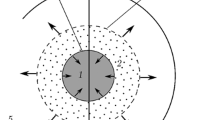Abstract
A study is made of the effect of a water sheath around a cylindrical explosive charge on the parameters of shock waves in rocks. A coupled problem for the detonation-product-water-rock system is examined within the framework of continuum mechanics. A binomial isentropic equation is used for the detonation products, water is modeled by a Tate-type equation, and the rock is modeled by an elastoplastic medium which undergoes dilatation. A numerical solution is obtained by a finite-difference scheme. The dependence of the wave processes in the rock and the dimensions of the crushing zone on the radius of the water sheath is studied with the use of sandstone and siltstone as examples.
Similar content being viewed by others
References
A. A. Vovk and A. V. Mikhalyuk, “Singularities of wave processes in a soil mass subjected to the explosion of charges with air sheaths,”Prikl. Mekh. Tekh. Fiz., No. 2, 105–110 (1972).
A. A. Vovk, G. I. Chernyi, and A. V. Mikhalyuk, “Fundamental laws of explosions of charges with air sheaths in soils,” in:The Use of Blasting in the National Economy [in Russian], Nauk. Dumka, Kiev (1970), pp. 115–121.
S. M. Kapustyanskii and V. N. Nikolaevskii, “Quantitative formulation of an elastoplastic dilatation model (using sandstone as an example),”Izv. Akad. Nauk SSSR Mekh. Tverd. Tela, No. 4, 113–124 (1984).
S. M. Kapustyanskii and V. N. Nikolaevskii, “Parameters of an elastoplastic dilatation model for minerals,”Prikl. Mekh. Tekh. Fiz., No. 6, 145–150 (1985).
V. M. Kuznetsov, “Efficiency of explosions in soil,”Prikl. Mekh. Tekh. Fiz., No. 4, 30–34 (1963).
G. M. Lyakhov,Waves in Soils and Porous Multicomponent Media [in Russian], Nauka, Moscow (1982).
V. N. Rodionov, V. V. Adushkin, V. N. Kostyuchenko, et al.,Mechanical Effects of Underground Explosions [in Russian], Nedra, Moscow (1971).
V. N. Mosinets,Crushing and Seismic Effects of Explosions in Rocks [in Russian], Nedra, Moscow (1976).
V. N. Rodionov,Improving the Efficiency of Explosions in Solids [in Russian], Izd. IGD im. Skochinskogo, Moscow (1962).
M. L. Wilkins, “Calculation of elastoplastic flows,” in:Computational Methods in Hydrodynamics [Russian translation], Mir, Moscow (1967), pp. 212–263.
F. A. Baum, L. P. Orlenko, K. P. Stanyukovich, et al.,Physics of Explosions [in Russian], Nauka, Moscow (1975).
V. N. Nikolaevskii, A. N. Polyanichev, E. V. Sumin, et al., “Dilatation effects in an underground explosion. Numerical study,”Dokl. Akad. Nauk SSSR,250, No. 1, 66–70 (1980).
Additional information
Institute of Hydromechanics, National Academy of Sciences of Ukraine, Kiev, Ukraine. Translated from Prikladnaya Mekhanika, Vol. 35, No. 3, pp. 83–88, March, 1999.
Rights and permissions
About this article
Cite this article
Remez, N.S. Deformation of rock in the explosion of a cylindrical charge in a coaxial cavity filled with liquid. Int Appl Mech 35, 295–300 (1999). https://doi.org/10.1007/BF02682126
Received:
Issue Date:
DOI: https://doi.org/10.1007/BF02682126




